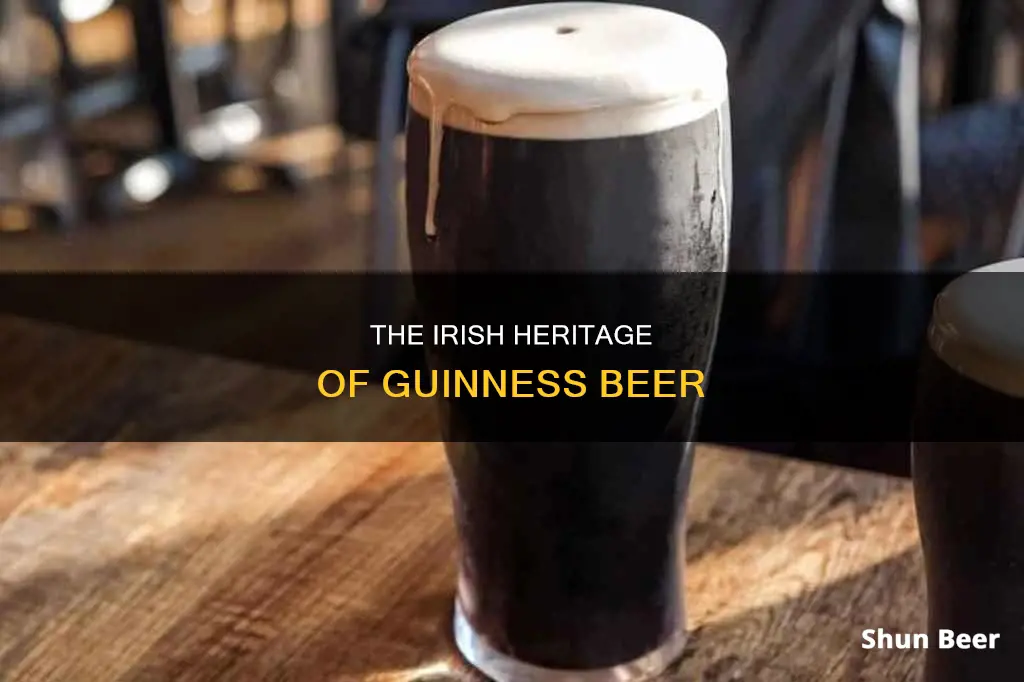
Guinness is a stout beer that originated in Dublin, Ireland, in the 18th century. It is now available in over 120 countries and is the most popular draught beer in the UK. The beer is brewed under licence in several countries, including Nigeria, the Bahamas, Canada, Cameroon, Kenya, Uganda, South Korea, Namibia, and Indonesia. Guinness has a rich history and has become an emblem of Ireland, with its distinctive black liquid and creamy head becoming iconic. The brand has also been associated with Irish culture and heritage, adopting the harp as its logo, which is now the official national emblem of Ireland.
| Characteristics | Values |
|---|---|
| Country of origin | Ireland |
| City of origin | Dublin |
| Brewery of origin | St. James's Gate Brewery |
| Founder | Arthur Guinness |
| Year founded | 1759 |
| Current owner | Diageo |
What You'll Learn

Guinness was founded in Dublin, Ireland, in 1759
Guinness is a stout beer that was first brewed in Dublin, Ireland, in 1759. On 31 December of that year, Arthur Guinness signed a 9,000-year lease on St. James's Gate Brewery in Dublin. At first, Guinness brewed a variety of ales and beers, but from 1799, the company concentrated exclusively on porter, a dark beer with a rich head. This beer later became known as stout.
Guinness has a long and interesting history. The company was founded when Arthur Guinness bought a small brewery in Dublin in 1759. Arthur Guinness was a philanthropist, a pragmatist, an innovator, a family man, and a fighter. He was also the first in a long line of Guinness Master Brewers, and the craft of brewing at St. James's Gate Brewery was handed down from generation to generation.
Guinness initially brewed ales, but soon embraced the new style of beer that was becoming popular: porter. By 1779, the Guinness Brewery was listed as one of two official suppliers of beer and ale to the seat of government at Dublin Castle. Five years later, it was the exclusive porter supplier. By 1799, Guinness had stopped brewing ales altogether in favour of darker brews.
Guinness became Ireland's largest brewery in 1838 and the world's largest by 1886, producing 1.2 million barrels annually. Today, Guinness is owned by Diageo, a British multinational beverage company, and it is brewed in almost 50 countries and available in over 120. It is one of the most successful alcohol brands worldwide.
Guinness Beer's Ball: A Unique Brewing Mystery
You may want to see also

The company merged with Grand Metropolitan in 1997 to form Diageo
Guinness is a stout that originated in the brewery of Arthur Guinness at St. James's Gate, Dublin, Ireland, in the 18th century. In 1932, the company moved its headquarters to London.
In 1997, Guinness plc merged with Grand Metropolitan to form Diageo plc, a multinational alcoholic drinks producer based in London. The merger created a $33 billion conglomerate, with Grand Met shareholders owning 52.7% of the new company and Guinness shareholders owning the rest. The new company, GMG Brands, united famous global brands such as Burger King, Johnnie Walker scotch, Pillsbury, and Guinness stout under one roof.
The merger was driven by the complementary strengths of the two companies in terms of products and geography, as well as the potential to boost the prospects of their respective wine and alcohol units by combining them to form the world's largest distiller and vintner. The combined company would have annual sales of about $22 billion, pretax earnings of $2.2 billion, and a market value of $37 billion. It was expected to rank as the world's seventh-largest food and drink company in terms of the total value of its shares.
Due to controversy over the merger, Guinness was maintained as a separate entity within Diageo and has retained the rights to the Guinness brand and associated trademarks.
Guinness Beer vs. World Records: What's the Difference?
You may want to see also

Guinness is now available in over 120 countries
Guinness stout was first brewed in Dublin, Ireland, in the 18th century. It is now available in over 120 countries and is brewed in almost 50 countries.
The story of Guinness began in 1759 when Arthur Guinness signed a 9,000-year lease on St. James's Gate Brewery in Dublin. Initially, Guinness brewed ales, but soon switched to producing a new style of beer called porter. By the 1790s, Guinness was listed as one of two official suppliers of beer and ale to Dublin Castle, and by 1799, the company had stopped brewing ales altogether, focusing solely on darker brews.
Guinness became Ireland's largest brewery in 1838 and, by 1886, it was the world's largest, producing 1.1 to 1.2 million barrels of beer annually. The company remained a family business for five generations until changes in ownership began in the latter half of the 20th century. Today, Guinness is owned by Diageo, a British multinational beverage company.
Guinness has become an iconic symbol of Ireland and is now available worldwide. The brand has expanded its reach to over 120 countries, with a significant presence in Africa, where about 40% of total Guinness volume is brewed and sold. The first recorded shipment of Guinness to Africa arrived in Sierra Leone in 1827, and the first Guinness brewery outside of Ireland and the UK was established in Nigeria in 1962.
Guinness has also adapted to different markets by introducing variations of its stout, such as Guinness Extra Stout, Foreign Extra Stout, and Guinness Smooth, ensuring its popularity in diverse regions. The brand continues to innovate and expand its global presence, solidifying its status as one of the most successful alcohol brands in the world.
The Irish Pride: Guinness Beer's Roots and Heritage
You may want to see also

The Guinness Storehouse in Dublin is Ireland's most popular tourist attraction
Guinness is a stout that originated in Dublin, Ireland, in the 18th century. The Guinness Storehouse, located at St. James's Gate Brewery in Dublin, is a popular tourist attraction that has welcomed over 20 million visitors since its opening in 2000. It is Ireland's most visited attraction, offering a unique and immersive experience for visitors eager to learn about the history of this iconic beer.
The Storehouse is a converted brewing facility that houses a museum dedicated to all things Guinness. Spanning seven floors, the building is designed in the form of a giant pint of Guinness, with a glass atrium at its centre. Each floor offers a different experience, taking visitors on a journey from grain to glass. The ground floor introduces visitors to the four key ingredients of Guinness—water, barley, hops, and yeast—and the brewery's founder, Arthur Guinness.
As visitors ascend the floors, they are treated to a wealth of exhibits and interactive experiences. They can learn about the artful brewing process, explore the company's history, and discover the famous Guinness advertising campaigns. The Perfect Pint bar invites visitors to try their hand at pouring the perfect pint, a carefully prescribed process that takes nearly two minutes. There are also several restaurants and eateries throughout the Storehouse, offering delicious food and curated beer pairings.
The highlight of the Guinness Storehouse experience is undoubtedly the Gravity Bar on the seventh floor. Here, visitors can savour a complimentary pint of Guinness while taking in breathtaking 360-degree views of Dublin and the working brewery below. The Gravity Bar is a popular destination, offering the perfect spot to relax and enjoy the sights of the city.
In addition to the standard self-guided tour, the Guinness Storehouse offers a range of premium experiences, such as the Connoisseur Experience, which provides a deeper insight into the origins and tastes of Guinness. Visitors can also embark on the Guinness Brewery Experience, exploring the working brewery that has stood at St. James's Gate for over three centuries.
The Guinness Storehouse is easily accessible, located within walking distance of Dublin's city centre. It is a must-visit destination for anyone interested in beer, offering an entertaining and educational experience that showcases the unique history and brewing process of one of Ireland's most iconic brands.
Guinness Beer: High Iron Content or Just a Myth?
You may want to see also

Guinness is the most popular draught beer in the UK
Guinness is a stout beer that originated in Dublin, Ireland, in the 18th century. It is now owned by the British-based multinational alcoholic beverage company Diageo. Guinness is available in over 120 countries and is one of the most successful alcohol brands worldwide.
In recent years, Guinness has experienced a surge in popularity in the UK, becoming the country's most popular draught beer in 2023. One in every nine pints sold in UK bars is Guinness, which has recently overtaken Carling as the top-selling beer in British pubs. This rise in popularity is particularly notable given that Guinness was considered "no longer cool" just a decade ago, with sales slumping amid a wave of new craft beers and easy-drinking lagers.
So, what has driven this resurgence? According to beer branding journalist Pete Brown, Guinness refocused its brand by going "back to basics". This included the success of the Storehouse brewery experience in Dublin and the launch of its long-running "Made of more" advertising campaign. Guinness also subtly refined its branding to reinforce its heritage, such as redrawing the harp logo by hand for a more rugged feel and introducing "Estd 1759" along with the signature of the founder, Arthur Guinness.
Big-budget ad campaigns have also contributed to the brand's success, positioning Guinness as ruggedly masculine with a softer side, drawing on core brand values of "power", "goodness", and "communion". Additionally, Guinness has doubled down on its association with Ireland by promoting St Patrick's Day and inventing the holiday Arthur's Day to celebrate its founder.
The rise in popularity of Guinness may also be partly due to a backlash against the craft ale trend that has dominated in recent years. Some drinkers view Guinness as a "`no-frills alternative`" to overpriced IPAs, particularly during a time of high inflation. Additionally, the new taste for more complex beers has boosted Guinness's popularity, as lager drinkers find it easier to transition to Guinness than craft ale due to its flavour, coldness, and creaminess.
Guinness has also been successful in capturing the attention of younger drinkers, with dedicated content for social media platforms such as Facebook, Instagram, and YouTube. The brand has also encouraged user-generated content, such as the #LooksLikeGuinness campaign during the COVID-19 lockdowns, which built anticipation for the reopening of pubs.
Guinness Beer and Coffee: What's the Connection?
You may want to see also
Frequently asked questions
Guinness beer is from Ireland.
Guinness was first brewed in 1759 at St. James's Gate Brewery in Dublin, Ireland.
Guinness was founded by Arthur Guinness.
Guinness stout is made from water, barley, hops, and yeast.
Guinness is available in over 120 countries.







